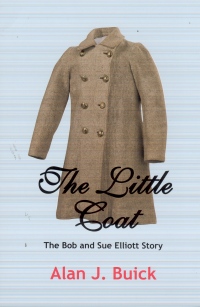| ________________
CM . . . . Volume XVI Number 29. . . .April 2, 2010. 
 |
The Little Coat: The Bob and Sue Elliott Story.
Alan J. Buick.
Regina, SK: DriverWorks Ink (www.driverworks.ca), 2009.
176 pp., pbk., $19.95.
ISBN 978-0-9810394-3-5.
Subject Headings:
World War, 1939-1945-Netherlands.
Netherlands-History-German occupation, 1940-1945.
Soldiers-Canada-Biography.
Grades 5-8. / Ages 10-13.
Review by Thomas F. Chambers.
****/4
|
| |
|
 excerpt:
The next morning, while compiling a list of all the repairs the tank needed, Bob’s crew was approached by a small Dutch girl who appeared much younger than her 10 years. Her clothes were worn to an almost threadbare condition with her elbows showing through the sleeves of her coat. Her well-kept blonde hair was tied up in neat pigtails, however, and indicated a preservation of her self-respect in contrast to the condition of her clothes. She also had a brightness in her eyes that seemed to say, “I know in my heart that everything is going to be alright.”
The Little Coat is the story of two families, the Cretiers, a Dutch family who lived in Rossum, the Netherlands, and the Elliott’s who lived in Calgary, AB, and how World War II brought them together. It is a war story with a difference. There are the usual topics of fear and excitement felt by all soldiers contemplating battle, but there is also a great deal about irrepressible human kindness and joy in the face of adversity. The Netherlands under German occupation, as described in this book, reminds one of the famous quotation by Martin Luther King Jr. that “no lie can live forever.” The occupation was evil, and it was wrong, and it was eventually, like segregation, overcome. The little coat in the title of this book is proof, in this case, of the King quote.
There are 13 chapters in The Little Coat. The first three are about the Netherlands, the Cretier family and the German occupation. Chapters four, five and six deal with the exploits of Bob Elliott who, after lying about his age, joined the Canadian army at 15. Reading about the Cretiers, we learn a considerable amount about the hardships faced by the Dutch during the war. Bob Elliott’s story tells about the rigours of training for British soldiers prior to D Day, the invasion of Europe, and of the challenges soldiers faced after landing. The next four chapters tell the story of the Canadian army’s struggle to liberate the Netherlands and of Bob Elliott’s meeting with 10-year-old Sussie Cretier.
Sussie’s father had been in the Dutch Underground, and he had to flee or risk being executed. The family escaped to Alphen, and it was here that Sussie met Bob and his tank crew. He and his mates became so fond of Sussie that, as a Christmas present, they had a coat made for her from an army blanket. Added to this gift were shoes, a scarf and a sweater that soldiers on leave brought back from Paris. Sussie, in her new clothes, symbolizes the liberation of the Dutch and the strong bond that formed between them and the Canadian army. Because The Little Coat is about ordinary people doing extraordinary things, it becomes very meaningful because it is a story to which readers can relate. The Little Coat has a fairy tale quality about it because Bob and Sussie meet again many years after the war, (both of their marriages had failed) fall in love and marry.
The Little Coat has a short bibliography of Internet sites. It uses footnotes to explain a number of things, such as the National Socialist Movement in the Netherlands, which would otherwise be confusing to children. These are more useful than the inclusion of a glossary and the turning to the end of the book for information would have been. There are 11 pages of functional, but poor quality, black and white photographs grouped together in several locations. There are, in addition, a very poor map of the Northern Front (where the battles mentioned in this book took place) from October 16, 1944 to November 10, 1944 and a small map of the Rossum area mentioned in the book.
Alan Buick, who wrote The Little Coat, is a carpenter, musician and songwriter. This is his first book. He became interested in the story when he saw Sussie’s coat on display in the Canadian Legion in Olds, AB. He has an idiosyncratic way of writing that detracts from the overall quality of the book. One example, “the windows all had the glass busted out of them." The windows had all been broken would have been more appropriate. Apart from this, The Little Coat is a fine story and well told.
Highly Recommended.
Thomas F. Chambers, a retired college teacher, lives in North Bay, ON.

To comment on this title or this review, send mail to
cm@umanitoba.ca.
Copyright © the Manitoba Library Association. Reproduction for personal use is permitted only if this copyright notice is maintained. Any other reproduction is prohibited without permission.
NEXT REVIEW |
TABLE OF CONTENTS FOR THIS ISSUE- April 2, 2010.
AUTHORS |
TITLES |
MEDIA REVIEWS |
PROFILES |
BACK ISSUES |
SEARCH |
CMARCHIVE |
HOME |
